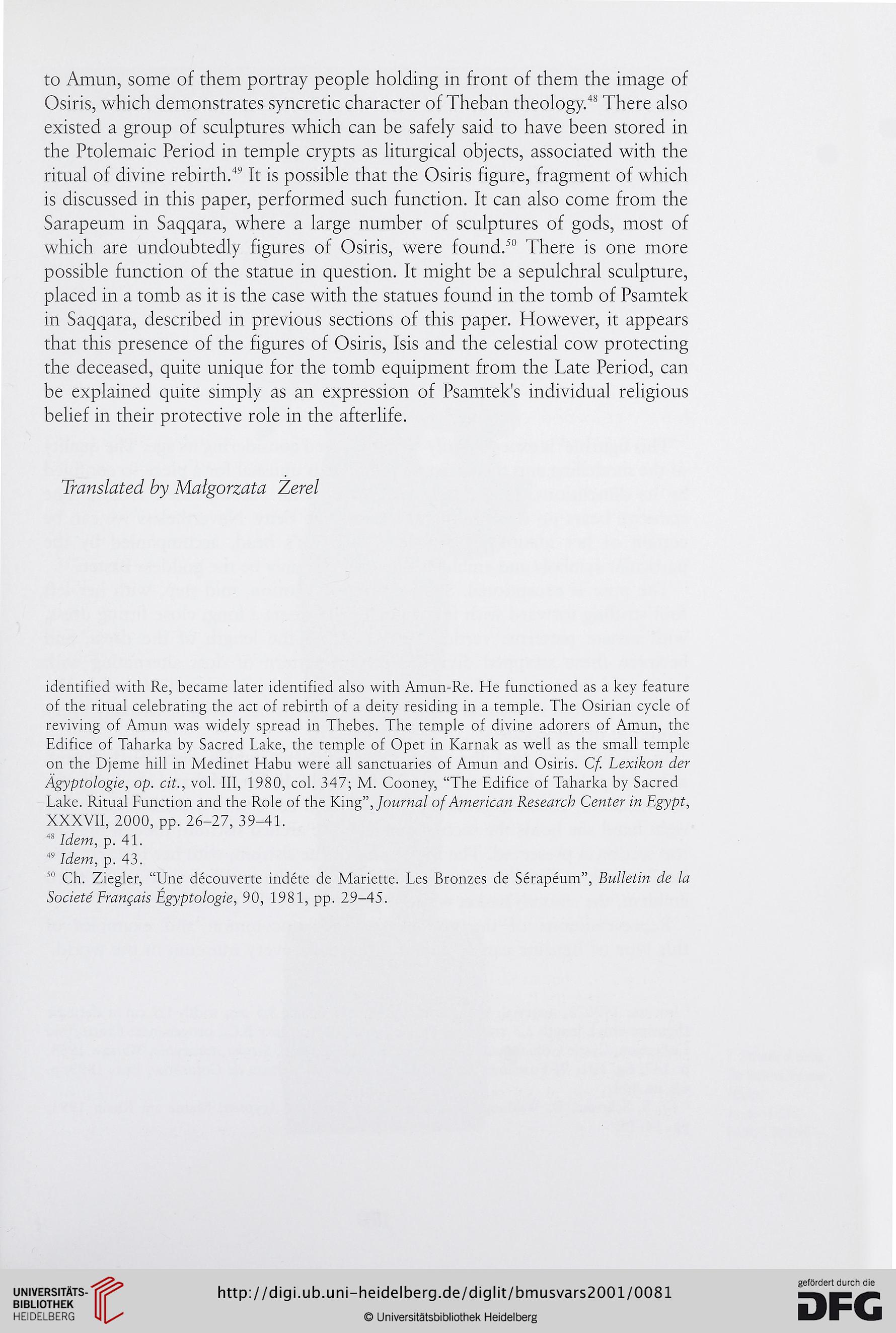to Amun, some of them portray people holding in front of them the image of
Osiris, which demonstrates syncretic character of Theban theology.48 There also
existed a group of sculptures which can be safely said to have been stored in
the Ptolemaic Period in tempie crypts as liturgical objects, associated with the
ritual of divine rebirth.49 It is possible that the Osiris figurę, fragment of which
is discussed in this paper, performed such function. It can also come from the
Sarapeum in Saqqara, where a large number of sculptures of gods, most of
which are undoubtedly figures of Osiris, were found.50 There is one morę
possible function of the statuę in question. It might be a sepulchral sculpture,
placed in a tomb as it is the case with the statues found in the tomb of Psamtek
in Saqqara, described in previous sections of this paper. However, it appears
that this presence of the figures of Osiris, Isis and the celestial cow protecting
the deceased, quite unique for the tomb equipment from the Late Period, can
be explained quite simply as an expression of Psamtek's individual religious
belief in their protective role in the afterlife.
Translated by Małgorzata Zerel
identified with Re, became later identified also with Amun-Re. He functioned as a key feature
of the ritual celebrating the act of rebirth of a deity residing in a tempie. The Osirian cycle of
reviving of Amun was widely spread in Thebes. The tempie of divine adorers of Amun, the
Edifice of Taharka by Sacred Lakę, the tempie of Opet in Karnak as well as the smali tempie
on the Djeme hill in Medinet Habu were all sanctuaries of Amun and Osiris. Cf. Lexikon der
Agyptologie, op. cit., vol. III, 1980, col. 347; M. Cooney, “The Edifice of Taharka by Sacred
Lakę. Ritual Function and the Role of the King”, Journal of American Research Center in Egypt,
XXXVII, 2000, pp. 26-27, 39-41.
48 Idem, p. 41.
49 Idem, p. 43.
50 Ch. Ziegler, “Une decouverte indete de Mariette. Les Bronzes de Serapeum”, Bulletin de la
Societe Franęais Egyptologie, 90, 1981, pp. 29-45.
Osiris, which demonstrates syncretic character of Theban theology.48 There also
existed a group of sculptures which can be safely said to have been stored in
the Ptolemaic Period in tempie crypts as liturgical objects, associated with the
ritual of divine rebirth.49 It is possible that the Osiris figurę, fragment of which
is discussed in this paper, performed such function. It can also come from the
Sarapeum in Saqqara, where a large number of sculptures of gods, most of
which are undoubtedly figures of Osiris, were found.50 There is one morę
possible function of the statuę in question. It might be a sepulchral sculpture,
placed in a tomb as it is the case with the statues found in the tomb of Psamtek
in Saqqara, described in previous sections of this paper. However, it appears
that this presence of the figures of Osiris, Isis and the celestial cow protecting
the deceased, quite unique for the tomb equipment from the Late Period, can
be explained quite simply as an expression of Psamtek's individual religious
belief in their protective role in the afterlife.
Translated by Małgorzata Zerel
identified with Re, became later identified also with Amun-Re. He functioned as a key feature
of the ritual celebrating the act of rebirth of a deity residing in a tempie. The Osirian cycle of
reviving of Amun was widely spread in Thebes. The tempie of divine adorers of Amun, the
Edifice of Taharka by Sacred Lakę, the tempie of Opet in Karnak as well as the smali tempie
on the Djeme hill in Medinet Habu were all sanctuaries of Amun and Osiris. Cf. Lexikon der
Agyptologie, op. cit., vol. III, 1980, col. 347; M. Cooney, “The Edifice of Taharka by Sacred
Lakę. Ritual Function and the Role of the King”, Journal of American Research Center in Egypt,
XXXVII, 2000, pp. 26-27, 39-41.
48 Idem, p. 41.
49 Idem, p. 43.
50 Ch. Ziegler, “Une decouverte indete de Mariette. Les Bronzes de Serapeum”, Bulletin de la
Societe Franęais Egyptologie, 90, 1981, pp. 29-45.




